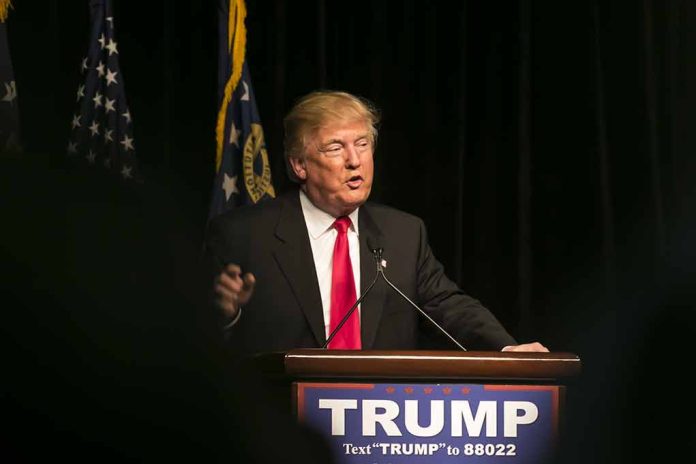
President Trump’s fiscal discipline slashes national debt growth by 92% compared to Biden’s reckless spending, potentially setting the stage for America’s first balanced budget in over two decades.
Key Takeaways
- Under President Trump, national debt grew by only $37 billion from January to May 2024, compared to $478 billion during the same period under Biden.
- Trump’s Department of Government Efficiency has implemented significant federal spending cuts, helping reduce the $26.2 trillion national debt by $5.5 billion.
- Revenue increases from Trump’s business-friendly policies and tariff regime have contributed to fiscal improvement, with corporate tax revenue up 15%.
- Trump’s approval rating has climbed to 53%, with notable gains among younger voters aged 18-29.
- Trump aims to balance the federal budget for the first time in 24 years through continued fiscal discipline.
Trump’s Fiscal Turnaround Shows Immediate Results
President Trump’s promise to restore fiscal responsibility to Washington is already bearing fruit just months into his second term. The numbers tell a compelling story: between January 22 and May 6, 2024, the national debt increased by only $37 billion under Trump’s leadership. This represents a dramatic 92% reduction compared to the Biden administration, which added a staggering $478 billion during the same period last year. This significant slowdown in debt accumulation comes as Trump implements targeted spending cuts and revenue-enhancing policies that have been sorely lacking during the previous administration’s free-spending approach.
The Department of Government Efficiency, a cornerstone of Trump’s second-term agenda, has been instrumental in identifying and eliminating wasteful federal spending. Their efforts have already resulted in a $5.5 billion reduction in the $26.2 trillion national debt, marking the first meaningful steps toward fiscal solvency in years. This stands in stark contrast to the Biden era’s endless government expansion, where trillions were directed toward pet progressive projects while American taxpayers struggled under the weight of inflation and economic uncertainty.
“President Donald Trump is making good on his campaign promises,” said Sarah Arnold
Revenue Growth Through Smart Economic Policy
Trump’s approach to economic management isn’t just about cutting expenses—it’s also focused on growing America’s revenue base through pro-business policies and strategic tariffs. Corporate tax revenue has increased by 15% as American businesses thrive under a regulatory environment that encourages growth rather than punishing success. Additionally, Trump’s tariff policies have generated nearly $6 billion in additional revenue, proving that his America First trade stance delivers real financial benefits to American taxpayers while protecting domestic industries from unfair foreign competition.
During his recent address to a joint session of Congress, Trump emphasized the importance of tariffs in protecting American jobs and ensuring fair trade relationships. He outlined a policy of reciprocity in trade, promising to impose tariffs on countries with significant trade deficits with the United States. This approach stands in sharp contrast to the previous administration’s weak stance on trade, which allowed foreign competitors to take advantage of American markets while restricting access to their own.
Comprehensive Fiscal Reform Agenda
In his joint address to Congress, Trump laid out a comprehensive fiscal reform agenda that extends beyond simple spending cuts. He urged Congress to extend tax cuts and proposed eliminating taxes on tips, overtime, and Social Security benefits—measures that would provide immediate relief to working-class Americans without derailing the budget. This balanced approach to fiscal management aims to stimulate economic growth while responsibly managing government expenditures, a stark contrast to the Biden administration’s policy of taxing and spending with little regard for long-term consequences.
“I signed an order making it the official policy of the United States government that there are only two genders, male and female,” said Trump
Trump’s fiscal reforms extend to areas that were flagships of wasteful spending under Biden. He has terminated the costly Green New Deal initiatives and withdrawn from the Paris Climate Accord, which placed unfair financial burdens on American taxpayers while giving other major polluters a pass. Additionally, Trump has targeted waste in foreign aid, calling out absurd expenditures like funding male circumcision programs in Mozambique while American infrastructure crumbled. His commitment to scrutinizing every dollar of government spending marks a return to responsible governance after years of runaway spending.
Growing Public Support for Fiscal Discipline
The American people are taking notice of Trump’s fiscal leadership, with his approval rating climbing to 53%. Particularly notable is his 13-point surge in support among voters aged 18-29, a demographic that has witnessed firsthand the devastating economic impacts of Biden’s policies on their career prospects and cost of living. Young Americans, burdened with student loans and facing housing costs that spiraled out of control under Biden, are increasingly recognizing that Trump’s fiscal discipline offers them a more secure economic future.
“In comparison, under Joe Biden, the worst president in American history, there were hundreds of thousands of illegal crossings a month, and virtually all of them, including murderers, drug dealers, gang members and people from mental institutions and insane asylums were released into our country. Who would want to do that,?” stated Trump
As Trump continues to implement his fiscal agenda, the contrast with the previous administration becomes increasingly stark. Under Biden, Americans suffered through the highest inflation in decades, crushing energy costs, and skyrocketing food prices—all direct consequences of reckless spending and anti-business policies. Trump’s commitment to balancing the federal budget for the first time in 24 years represents not just a financial goal, but a fundamental reset of government priorities that puts American taxpayers first after years of being treated as an afterthought.



